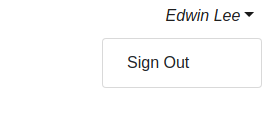簡單來說是用來存放一些狀態的地方,你可以讀取、監聽、修改這些值。
例如你在A頁打了一支API做登入,那使用者的狀態就變了,可能同時有幾個components要對應做頁面調整,顯示會員的功能之類,就可以用這個Vuex來做控制。
來建一個store
src/store/modules/user.js
const state = () => ({
info: {
id: "",
name: "Guset", // 預設是遊客
isLogin: false // 還沒登入
},
})
// 這可以用來寫一些取值的function,需要邏輯運算的
const getters = {
}
// Action是提交mutation不會直接更新state
const actions = {
// 登入
login ({ commit }, payload) {
let info = {
id: payload.id,
name: payload.name,
isLogin: true
}
commit('setUserInfo', { items: info })
},
// 登出
logout ({ commit },) {
let info = {
id: "",
name: "Guset",
isLogin: false
}
commit('setUserInfo', { items: info })
}
}
const mutations = {
// 更新state的值
setUserInfo (state, { items }) {
state.info = items
},
}
export default {
namespaced: true,
state,
getters,
actions,
mutations
}
把這個user store import進來
src/store/index.js
import Vue from 'vue'
import Vuex from 'vuex'
import user from './modules/user'
Vue.use(Vuex)
export default new Vuex.Store({
modules: {
user
},
strict: true
})
views/App.vue
// 更新user store
if (resp.data.data.is_login === true) {
self.$store.dispatch('user/login', {
id: resp.data.data.user_id,
name: resp.data.data.user_name,
})
}
views/App.vue
import { mapState } from 'vuex'
computed: {
// 當store值一更變,這邊也會自動更新
...mapState({
userState: state => state.user.info
}),
},
這樣就可以用來做權限的控管囉
<b-nav-item-dropdown right>
<template v-slot:button-content>
<em>{{userState.name}}</em> <!--顯示會員名稱-->
</template>
<!-- 如果還沒登入就顯示Sign In -->
<b-dropdown-item v-if="!this.userState.isLogin" v-b-modal.modal-1>Sign In</b-dropdown-item>
<!-- 如果還登入了就顯示Sign Out -->
<b-dropdown-item v-else v-on:click="logout">Sign Out</b-dropdown-item>
</b-nav-item-dropdown>
已登入的狀態~
今天的commit
謝謝大家~
